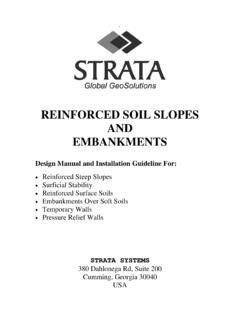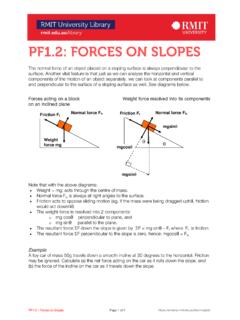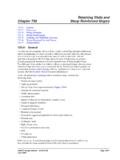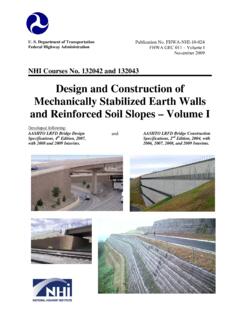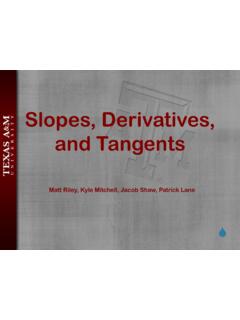Transcription of SLOPES AND BREAK - PuttingZone
1 SLOPES AND BREAKThe PuttingZone method for any golfer uses only two practice-green putts to establish and learn how much a putt breaks for a given slope and green speed, using that golfer s personal delivery pace, expressing the BREAK as either a percentage of the length of the putt or as so many inches of BREAK to play per foot of the putt distance, locating the aim-ing target this BREAK distance up along the fall line measured from the center of the cup, as applicable to all putts inside 15 feet so long as the surface presents the same flatness from ball to hole. In addition to this two-putt method, the paper delves into the basic art and science of perceiving fall lines, SLOPES , and breaks for the skilled golfer s know how, training skills that travel from putt to putt with minimal streakiness and slump-ing.
2 The end result is the golfer who makes a much higher quality effort than otherwise and specifically makes a higher quality effort relentlessly and ceaselessly compared to competitors. A skilled golfer may not sink the immediate specific putt, but the higher quality effort consistently applied pays huge benefits for score and for Geoff MUCH slope , KIND OF SLOW. 20 Aug 2012 GOLF ANLAGE SCHOPFHEIMP ractice Green Topography for Reading 518 Woodlawn Ave Greensboro NC USA 27401 (336) 340-9079 mobile ReadingsThis paper presents the PuttingZone method for using the practice green to learn the amount of BREAK that occurs for certain common or frequent combinations of green speed and slope steepness or grade.
3 The specific combination is a 2% slope grade tested at the usual green speed (commonly Stimp 9 to Stimp 10 in the United States, perhaps slower in the Spring), from the make range of 10 feet. This method is not a calculated BREAK , but is THE BREAK that applies to the specific golfer performing the testing. That is true because the golfer uses HIS OR HER PERSONAL DELIVERY PACE, in contrast to calculations of booklets that use an assumed or supposedly IDEAL delivery pace. Once the 2% slope is tested to find the BREAK , this BREAK can be adjusted for 1%, 3%, 4%, 5%, and 6% SLOPES at the same green speed and delivery pace by simple proportionality. Or the golfer can separately identify these SLOPES on the practice green and independently test for BREAK .
4 Once done, the golfer has a full understanding of paradigm patterns of slope and BREAK for that green speed, over the full range of SLOPES likely to have a pin location. If the testing is done when the green speed is the usual , the testing result will apply nearly all the time. Separate testing may be required for special green speeds, such as faster tournament-quality course preparation.[For those in a hurry, skip ahead to pages 9-12 for the basic 2-putt BREAK testing.]The principal aspects of the green that require accurate perception are 1) flatness; 2) slope grade or steepness, and 3) direction over the flat area that is straight uphill-downhill traditionally called fall lines, with the one thru the hole being primary.
5 Green speed perception is not that critical, and the testing in this method takes into account whatever the speed might be for the practice green and the course for that day, and also sorts out green speed when the tested speed is the usual speed. Green speed may vary slightly from hole to hole and day to day, but usual is a fat term that compre-hends about one-half a foot of Stimp speed, and greens typically don t vary over the course outside this fat range. And in any event, if the green speed does exceed the usual fat range, the skilled golfer knows what adjustment this requires for Mangum s PuttingZone !Reading Slope2 The calculated reading booklets that are currently available, incidentally, use delivery paces of the ball at the hole for all calculations that are not typically used by the vast majority of golfers and so are bad reads for almost all golfers.
6 (They were borrowed from a 1986 physics paper by a non-golfing physics teacher calculating optimal ball velocity across the hole just to do it, not to find real or actual velocities used by golfers.) Teaching golfers about what the BREAK is, even when wrong, can help, but it s better to do the testing as it applies to specific golfers and get it right to start with, and elimi-nate the golfer s having to try to make compensating differences in his or her usual pace or even misaiming of the start line in unmindful attempts to fit the golfer s putting pace and stroke to a computer s read. The PuttingZone approach is superior to these book-lets and applies only and accurately to the specific golfer, without necessitating any ef-fort to change the normal stroke and pace to fit to someone else s notion of the correct or best delivery pace.
7 And the breaks in this method are not calculated based upon necessary, simplifying assumptions, but are the exact analogue breaks that take into ac-count all the specific peculiarities that affect the BREAK this way basically requires nothing more than a little attention to the slope steepness and flatness of the surface in choosing the area of the practice green to perform the testing. Fundamentally, the golfer is trying to test and recognize slope dif-ferences on the course, concentrating on the frequently encountered cases, so that on the course the golfer sees and understands the specific putt he or she faces in terms of the tested paradigm patterns. The specific on-course putts will not exactly fit the tested paradigm patterns, but will be slightly different in any number of ways, so the golfer will naturally expect to make a minor adjustment away from the paradigm BREAK to de-cide exactly how much BREAK to play for the specific on-course putt.
8 But he will START making the adjustment with a great deal of confidence about the normal BREAK that is about right, and the adjustment will normally be very Mangum s PuttingZone !Reading Slope3 Preliminary and frequent SLOPES and limits on pinnable slope . What determines the size of the BREAK over a flat but tilted surface is the combination of slope steepness and the green speed that day. Obviously, the length of the putt and the delivery pace used by the golfer also factor in, but assuming that the golfer always uses the same delivery pace, the distance can be simplified to a percentage of the putt length or distance or to a conversion of inches of BREAK per feet of putt length or distance. And because the green speed is most often the usual or normal , in the end what really matters most to reading BREAK is the steepness of the slope at the golfer needs to be familiar with the most frequent combinations of slope and green speed, so he should test the most frequent SLOPES when the green speed is running at the speed he will be facing when he plays the course.
9 Greens typically are sloped between 0% and 6% grade, as above 6% grade a ball on a Stimp 10 green speed will not remain still but will roll off. According to USGA guidelines for fair pin locations, a pin should not be located on slope when the green speed won t allow the ball to rest there. Golf course architects know that greens are usually Stimp 10 or lower speed unless extra Geoff Mangum s PuttingZone !Reading Slope4trouble is taken to speed the grass up for special occasions, which are rare because this also endangers the health of the grass and cannot be a usual speed. Therefore, few greens present more than 6% slope ( degrees in the above chart, where the line from 10 at the left vertical scale intersects the red area, above on the bottom scale) except on steep tiers and limited areas of the green that are never pinnable locations and in any event the greenkeepers don t (usually) locate the hole on such a steep area.
10 Indeed, the recommended limit for pins when the green is Stimp 10 is degrees or grade (where the line from 10 meets the line at the yellow region above on the bottom scale). Green architecture factors affecting fall lines and slope steepness. Architectural cues to surface slope steepness and fall line orientations are: 1)noting that the overall slope of the green complex has underground French drainage pattern that collects and directs the subsurface water downhill into the basic drainage pattern of the hole and the course away from hills towards streams and lakes, and the basic physics of water running downhill usually requires about 2% grade as the minimum to ensure the water has sufficient velocity and momentum to avoid getting trapped and po-tentially upsetting the ecology of a healthy green.




